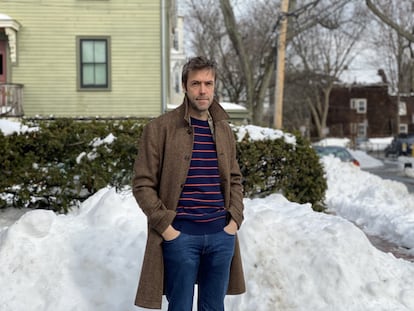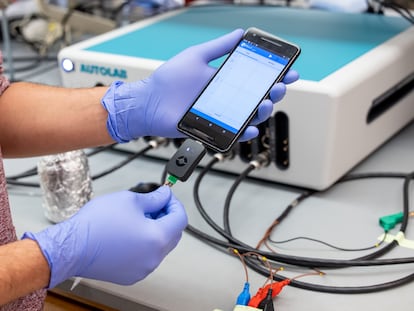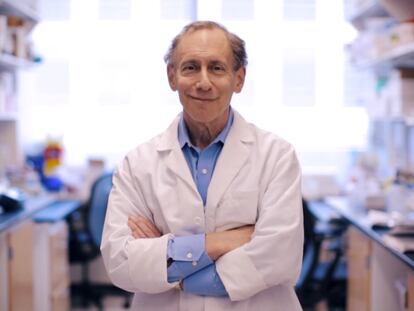Harvard epidemiologist William Hanage: ‘Pandemics don’t have an official endpoint, with cheers and fireworks’
The co-director of the Center for Communicable Disease Dynamics talks to EL PAÍS about the dangers of treating Covid as endemic, the importance of booster shots and why the health crisis isn’t over yet

Epidemiologist William Hanage says that he often travels to Spain for vacations. With nearly two feet of snow outside his home in Cambridge in the US state of Massachusetts, he is keen to go back to enjoy “tapas, good weather and a glass of Manzanilla.” The 48-year-old, who is the co-director of the Center for Communicable Disease Dynamics at Harvard University, is surprised to find out that outdoor masking has been mandatory in Spain since the end of December – a measure that will expire on Thursday. “Outdoors?” he asks in amazement during a video call with EL PAÍS.
The researcher, who was born in Penzance in England, is good at expressing his opinions on the Covid-19 pandemic in punchy statements. When it became clear a month and a half ago that the omicron variant of the coronavirus was less severe but more contagious, he told The Guardian: “The difference between a caress and a slap is largely in the pace with which it is given.” When the idea that Covid was already an endemic illness took hold in January, he wrote on Twitter: “Omicron is not endemic right now in much the same way that the Moon is not a hamster.” Although the epidemiologist thinks it’s “foolish” to say that the omicron variant will bring an end to the pandemic, he is convinced that life will not be the same after this wave.
Question. When will the Covid pandemic end?
Answer. The thing about pandemics is that they don’t have an official endpoint, when someone rings a bell and says, ‘right everything is over, back to work,’ cheers, fireworks. That doesn’t happen. Instead, you get waves of disease, which can be sometimes pretty bad, and it comes back a few times, and eventually, the epidemic reaches a point at which people consider the consequences to be tolerable. The only way in which you have a clean end to a pandemic is if you completely eradicate the virus. And once we’ve got something like omicron, and once we’ve got something that is infecting wild animal populations, that’s not going to happen.
Q. Some doctors say that omicron signals the end of the pandemic.
A. Yes, I don’t really get that. People are very eager to say that. Omicron is closer to the end of the pandemic if only because it is further along in time. In the United States, we’re seeing hospitalizations as high as they’ve ever been. We’re getting 2,000 deaths on average a day. If you look at the sheer number of cases omicron is causing, it’s pretty astronomical. The consequences of omicron are not likely to be small both in terms of the disease it causes and the immunity it generates. If you ask me to make an informed guess, I would think that following omicron, severe consequences in vaccinated younger people would be even rarer. But there will still likely be some concern about the introduction of the virus to older, very vulnerable host networks. I think that only people who are very optimistic or who have very short memories or bluntly, are a little bit foolish, make strong promises in the middle of a pandemic.
Q. What scenarios do you see for the future?
A. The best-case scenario is that the immunity generated by omicron and the quantity of vaccination that has happened means that we no longer see serious waves which cause effects on healthcare. The worst-case scenario is that a further variant arises and that variant is capable of causing either severe infection – I think that’s really unlikely – or at the very least, the variant is capable of causing chaos through the number of people it infects. That’s a lot of what omicron has done. It’s not only the people it lands in the hospital, it’s the fact that it infects the healthcare workers, so the capacity of the hospital to care for the people is reduced. Because once you take the trained nurse away from the intensive care bed, it’s not really an intensive care bed anymore. It’s just a bed with a machine next to it.
I did not wear a face mask outside throughout the recent omicron surge
Q. You are planning to go on vacation to Spain. In that country, more than 81% of the population is vaccinated.
A. That’s fantastic.
Q. And almost 100% of the over-70 population are vaccinated with at least two doses. Would you go to a nightclub or a big event in Spain?
A. I would always look at the local situation. I can give you an example from the delta wave. I’m a fan of the Arsenal football club. Towards the end of the summer, when cases were very low here, I would happily go to my local sports bar and watch a game, have a beer and chat to my friends. I wouldn’t have done that in the last few weeks, because we had a situation where about 10% of the population was infected with omicron.
Q. When will a grandchild be able to give his grandparents a kiss without worrying?
A. Everybody has been missing that. I’m always cautious about making promises, but I think that it’s reasonable to think that over the summer we may be getting numbers of cases that are sufficiently low that we are capable of returning to something like that. One thing I want to point out is that those older folks should be boosted. That’s really important. Right now in Massachusetts, we have fewer infections per capita than the United Kingdom, but almost twice as many deaths per capita. One of the reasons for this is that while the UK has managed to boost a very large fraction of its over-65 population, we’ve not. Last I checked, it was around 70%, as opposed to 90% in the UK. Seventy percent can sound like it’s almost as good as 90%, but it’s three times as bad. Because if you’ve protected 90% of the population, 10% are unprotected. If you’ve protected 70%, 30% are unprotected.
Q. In Spain, it is mandatory to wear a face mask outdoors in the street.
A. Outdoors?
Q. Yes, outdoors, regardless of the safety distance [Since this interview was conducted, Spain announced that the measure will be lifted on February 10.] Does this make sense?
A. I do not wear a face mask outdoors. I wear a face mask whenever I go indoors to a public space. To be honest, next winter I cannot see a really big downside to wearing a face mask to a grocery store or on public transport. I can imagine that under very, very serious circumstances with a strong surge, you might recommend that. But I did not wear a face mask outside throughout the recent omicron surge here.
Q. In Spain, people wear a mask outdoors on the street and take it off when they go into a bar.
A. That makes it very pointless! [Laughing] My favorite example of this which I really struggled to understand was the face masks in schools in the UK, where they insisted that students should wear masks while moving between classrooms. But once they had got into a classroom, and were sat next to the same people for an hour, they could remove the mask. These are misunderstandings about the actual nature of transmission.
Omicron is only a little bit milder. Most of the heavy lifting that you are seeing is being done by immunity
Q. Spanish Prime Minister Pedro Sánchez and British Prime Minister Boris Johnson have suggested we are approaching the moment of treating Covid-19 as an endemic disease such as the flu. Are we close to this point?
A. People don’t know what endemic means. They really don’t. Generally, when people speak of endemic disease, they mean a stable amount of disease which does not fluctuate greatly. But that doesn’t mean that it’s mild. Millions of people die of tuberculosis. Tuberculosis is an endemic disease in large parts of the world. Malaria is an endemic disease in large parts of the world. I think ‘endemic’ is the most recent epidemiological concept that has been taken by people and repurposed to mark a finish line, where people can say ‘oh we’re at that stage now, we don’t need to do anything.’ I think that’s dangerous. I think it’s also dangerous to say that we’re going to be in this state forever, because we are not.
Q. Do you think we are close to reaching a degree of stability?
A. I understand the hurry for people to move past it, but unfortunately, the more you assert the return to get back to normal by acting normal, the more abnormal things will be, because there will be more opportunities for the virus. Perhaps the most damaging thing over the last few years has been the determination of some folks to look at this and pretend it doesn’t exist. That’s the reason places have struggled so much. There have been many failures of leadership in places, and some of them can be excused. But what should not be excused is the failure to learn from your mistakes. In a pandemic, it is never too late to do better. Even though we are much closer to the end of the pandemic than the start, we should remember that we are still at a point where we can be saving lives by boosting. We can be saving lives by making sure that people who would have been severely ill and died do not get infected before they can be boosted. We can be saving lives by preparing for any future variants and preparing vaccine programs and understanding what we will do if something bad happens. Hope for the best, prepare for the worst.
Q. You tweeted that the pandemic is not endemic right now in much the same way the Moon is not a hamster.
A. That is correct. The Moon is not a hamster and omicron is not endemic. Endemic implies a constant amount of disease and looking at the case of omicron in Spain, it went from around 5,000 cases a day before omicron to a peak of more than 130,000 cases a day. Does that sound like stable, flatlining endemic to you? No. It doesn’t mean that there will never be an endemic state, but pretending that it is now is one of the most bizarre things I’ve seen over the course of the last two years, and I’ve seen some bizarre things.
Q. People are very tired of the pandemic. In Spain, many people have decided that the pandemic is over. In this country, nearly everybody is vaccinated (81%), many people have had Covid and more than 90% of the over-60 population is boosted. In this context, what would you recommend to a healthy and vaccinated person who is in a country where nearly everybody is vaccinated? What are we waiting for?
The more you assert the return to get back to normal by acting normal, the more abnormal things will be, because there will be more opportunities for the virus
A. I think that characterizing it as waiting is not the right way to think about it. There’s always a balance between what we want to do and the risks we are prepared to accept. A young, healthy person who is vaccinated going to a bar really is at very, very low risk. A young, healthy person going to a bar and then going to see an elderly relative shortly thereafter, not having taken a rapid test or any precautions, that’s what might lead to problems. There is also the chance of long Covid, which unfortunately is not as well studied as it should be. Some preliminary evidence suggests that it is less likely in people who are vaccinated. Younger people who are infected can have long-term side effects. For people who are at low risk, they should feel happy to do the things that they want to do, but they should also remember that firstly, things can change, and secondly, not everyone is lucky enough to be in the position they are in. What they can do to prevent the transmission of what is still a dangerous disease is still helpful.
Q. There is a widespread belief that infectious diseases evolve to become less virulent over time.
A. That’s completely false. For an infectious disease, what matters is transmission. If by being virulent you are more likely to transmit to another host, then virulence will be selected for. The first variant that we all heard of, alpha, was more likely to land you in hospital than the first virus, probably somewhere between 20% and 50%. One virus was replaced by a more dangerous virus, which was replaced by a yet more dangerous virus, delta. And now omicron has come along and people are saying it is mild, but it is only a little bit milder. Most of the heavy lifting that you are seeing is being done by immunity. The so-called Spanish flu of 1918 did not become milder because the virus became kinder, it was continuing to transmit to populations who had more and more immunity. And that is exactly what we have been seeing.
Q. So omicron is not Covid evolving to become a common cold.
A. No. Anybody who has dipped their toe in the sewer which is social media will have noticed that there are some people who are very much opposed to all restrictions, and basically want to just let the virus do whatever it wants to do. Then there are people who are opposed to any middle road who say we have to eradicate the virus and anything else is condoning mass death. Both those extremes are irrational. They are now increasingly, sadly, identified with political positions, and people are trying to hold on to them for non-scientific reasons. The basic thing in a pandemic is you try to stop your healthcare systems from being really overwhelmed. And a lot of places have flunked that, again and again. We do have a lot of things we can do to mitigate that transmission, but the most important thing is vaccines. Now we have those in a large number of people and now we have a significant fraction who have been infected and have immunity via infection, we expect the severity of the waves of the infection to reduce.
Tu suscripción se está usando en otro dispositivo
¿Quieres añadir otro usuario a tu suscripción?
Si continúas leyendo en este dispositivo, no se podrá leer en el otro.
FlechaTu suscripción se está usando en otro dispositivo y solo puedes acceder a EL PAÍS desde un dispositivo a la vez.
Si quieres compartir tu cuenta, cambia tu suscripción a la modalidad Premium, así podrás añadir otro usuario. Cada uno accederá con su propia cuenta de email, lo que os permitirá personalizar vuestra experiencia en EL PAÍS.
¿Tienes una suscripción de empresa? Accede aquí para contratar más cuentas.
En el caso de no saber quién está usando tu cuenta, te recomendamos cambiar tu contraseña aquí.
Si decides continuar compartiendo tu cuenta, este mensaje se mostrará en tu dispositivo y en el de la otra persona que está usando tu cuenta de forma indefinida, afectando a tu experiencia de lectura. Puedes consultar aquí los términos y condiciones de la suscripción digital.
More information
Últimas noticias
NASA discovers Titan doesn’t have an ocean, but a ‘slushy ice layer’ that increases possibility of life
Innocence lost in the forest of the child soldiers: ‘Each leader of the armed group had his girls’
‘Fallout’ or how the world’s largest company turned an anti-capitalist apocalyptic Western into a phenomenon
From inflation to defending migrants: Eileen Higgins and Zohran Mamdani inaugurate the new Democratic resistance against Trump
Most viewed
- ‘El Limones’ and the growing union disguise of Mexican organized crime
- Christian Louboutin: ‘Young people don’t want to be like their parents. And if their parents wear sneakers, they’re going to look for something else’
- The low-cost creative revolution: How technology is making art accessible to everyone
- ‘We are dying’: Cuba sinks into a health crisis amid medicine shortages and misdiagnosis
- Liset Menéndez de la Prida, neuroscientist: ‘It’s not normal to constantly seek pleasure; it’s important to be bored, to be calm’











































